
|
Did you ever hear the tragedy of Darth Plagueis the Wise? This article details the history of a character who no longer actively takes part in current events.
|
- "We did this to ourselves. Anakin wasn’t evil. He lived in the Order as we all did and ultimately our weakness was his downfall. We created Vader. We made that monster. Palpatine pushed him over the edge, but we led him to it."
- ―Jedi Master Omancor Crask speaks on the Jedi Order’s failure with Anakin Skywalker
Omancor Crask, also known as Darth Carnus and He who is krel os'a hmi va ta, was an exceptionally powerful Epicanthix Force-user active in the span between the Rise of the Empire and the Dark Jedi Brotherhood eras. As a Jedi Master he served in the Clone Wars as a General and was a veteran of numerous campaigns. When Emperor Palpatine issued Order 66, Crask—like many of his former Jedi comrades—fled persecution from the Empire and went into seclusion. He was also one of the few Jedi known to have fallen to the dark side to become a Sith Lord, and yet return to the light many years later having mastered both ethereal facets of the Force. However, Crask’s journey back from darkness did not take him as close to the light of the Force as he had once been. The experience would see him embark on a new path all his own as no one before him had ever done.
Character History
An Early Light - 68 BBY
Born on Panatha in 68 BBY, Crask was identified during infancy as being gifted with the Force. The Jedi Order removed him to Coruscant where he began his early training in the Jedi arts. Relative to his peers, Crask was very strong in the Force. Indeed a few Jedi Masters even thought Omancor could be the Chosen One. Gifted though he was, it was clear Crask’s talents lay in his early precision control over his abilities that took other students much longer to master. While it became evident his power in the Force did not run as deep as some, he developed a fine control that was seldom seen outside of the Masters.
Way of the Jedi – 57 BBY (11 years of age)
 Jedi Master Yur Talo'tan
Jedi Master Yur Talo'tan
In 57 BBY, Crask was accepted by the Elomin Jedi Master Yur Talo’tan as a Padawan. The young Epicanthix apprentice took easily to the rigorous training and beneficent instructions of his master. Crask saw early on that the galaxy was in desperate need of those who would stand for peace and order. He wholly believed the Jedi Order to be the greatest bulwark to the events and beings seemingly determined to destroy the tentative peace of the time.
Knighthood – 50 BBY (18 years of age)
At the age of 18 Crask’s exceptional control of his gifts saw him become one of the youngest Jedi of the time to be knighted. His reverence for the Force and belief that it was a gift bred in him a judicious and conservative mindset when calling its power. The Master’s Council was greatly concerned with commissioning Knights that shared their orthodox views of the Jedi’s role as protectors of the Republic despite the growing concern over the separation of Order and State. Crask wholeheartedly believed at the time that the Jedi were intrinsically bound to the Republic as it represented order, justice, and peace in the galaxy.
These tenuous concepts needed the care of those strong enough to ensure they would eventually take root elsewhere in a chaotic galaxy. For many Jedi like Crask, this was seen as their first duty and somewhere along the way the elusive Will of the Force was subordinated to the Will of the State. Unfortunately for Crask and the Jedi, their drive to protect peace and justice across the galaxy blinded them to the darkness rising in their midst.
Jedi Master – 32 BBY (36 years of age)
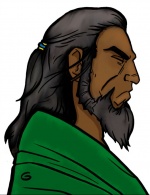 Jedi Master Omancor Crask in his days with the Order
Jedi Master Omancor Crask in his days with the Order
It was in the years following Crask’s ascension to Jedi Master that he began to see cracks in the veneer of the Order that led him to question their direction as Jedi. Before the Master ranks, many Jedi were not privy to the closed-door discussions of the Jedi Council. Nor were the younger of their Order aware of the elite circles of higher echelon Masters who debated grave issues not taught in the Jedi curriculum. It was clear to Crask in this time that much of what the Jedi had been taught were not whole and empirical truths, but partial ones. The deeper he examined what the Jedi Order was doing and why, the graver his concern became. Depsite this, Crask took his first apprentice, Meadan Clor.
The Clone Wars – 28 BBY (40 years of age)
 Crask saw several campaigns as a Jedi General
Crask saw several campaigns as a Jedi General
Like all wars, the Clone Wars struck at the most inopportune of times for Crask. He already questioned the Order’s direction and his place in it. When the war came, Omancor found himself again uncertain as to the role of the Jedi in the political and military turmoil. Though Jedi were martial in nature, they were not soldiers. Crask was suddenly a brevet general in an order he was unsure of and embroiled in a war in which he felt their position should be not to intervene.
It was also in this time that Crask struggled as to how to properly guide his apprentice Meadan Clor (born 49 BBY); a vibrant and gifted young woman with whom Crask’s relationship was criticized. Conflicted, the Jedi Master had difficulty reconciling his feelings for Meadan in the ways the Council deemed inappropriate. Throughout her mentorship the two grew closer despite everything to the contrary. Crask was at war internally with the orthodoxy of the Jedi Order and what he perceived as his own weakness for his feelings about Clor. Despite himself, Crask contravened traditional Jedi stoicism and embraced his feelings.
Order 66 – 19 BBY (49 years of age)
Near the end of the Clone Wars Order 66 was issued and Crask survived only to watch countless numbers of Jedi fall. Anakin Skywalker cut them down without mercy and the already disillusioned Jedi Master was unable to stop him. Fleeing with Meadan and a few other survivors Crask was torn between anguish and dark elation. Though the Order was decimated and the loss bitter to him, he also realized that his feelings for Meadan could be realized and explored.
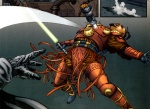 Koffi Arana slain by the sword of Shadday Potkin at the Conclave on Kessel
Koffi Arana slain by the sword of Shadday Potkin at the Conclave on Kessel
However, Crask’s apprentice did not survive the persecution of Skywalker now in the guise of Darth Vader. Meadan Clor was overwhelmed and killed by elements of Vader’s 501st Legion en route to the Conclave on Kessel. Having traveled separately to the Jedi meeting, Crask chose not to continue on upon learning of her death. The misfortune of Meadan’s death and providence of Crask’s decision worked in turn to save his life. No Jedi who attended the meeting at Kessel survived.
Descent – 19 BBY – 9 BBY (49 to 59 years of age)
Mercilessly hunted by the Empire, Crask fled from world to world in the wake of the Jedi Purge. Sometime in 9 BBY having been hunted for nearly 10 years, Crask did the unthinkable for a Jedi and sacrificed an innocent life to save himself. Whether out of madness or instinct, Crask was deeply troubled by the act and unable to reconcile what he thought he was with what he seemed to have become. His dissolution, anger, and isolation had finally overwhelmed him to the point where he could no longer find even the slightest comfort or answer in the light side of the Force.
In the years following the Great Jedi Purge Crask had ample time to consider what had befallen them. Bitterness took hold within him as he examined every aspect of how Palpatine had made fools of them. Omancor remarked on how pompous they had been to think themselves impervious to threat. The more he contemplated their destruction, the more he believed that the fault was not with Palpatine or Vader, but themselves. He felt the Jedi were to blame for their arrogance, naïveté, and intractability.
Crask spent months visiting remote worlds free of inhabitants and distraction. He turned inward for answers to the questions that plagued him and found little solace. Finally Crask realized that he could find no answers in the Jedi way of the Force because he was no longer a Jedi in that sense. He had become something else in the interim of the Purge that had perhaps found its origin in him even before Palpatine issued his fateful order. He had done what was necessary to survive to include the taking of an innocent life. He had done finally what best served him alone.
This concept began to foment in his mind as the only valid course of action available to him. If he served no one, then he served himself. Crask reasoned that if this was the case then he was no longer bound by the strictures of the Jedi Order, the light side of the Force, or any code at all. His anger and nihilism deepened as he began to see that had he, the Order, or any of the Jedi been willing to do what was necessary, then Order 66, the Purge, the destruction of their way of life and the ascension of those with the courage of their convictions could never have come to pass. For Crask, if there was no light to guide his way, then there was only darkness.
Sith Absolutism – 9 BBY – 18 ABY (59 to 86 years of age)
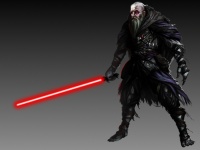 Darth Carnus
Darth Carnus
It was in this time that Crask recognized himself as having fully separated from the light. His moral quandary over what he had become had long since faded to memory and he concerned himself with the progression of his skills unbound by Jedi law. As any follower of an old path would, Crask looked to those who had tread into darkness before him and studied the Sith Lords of old. In copies of ancient texts he found wisdom from the stigmatized perspective of the Sith and other adherents of arts without the light.
As he learned more of what the Council had suppressed, his anger ran deeper than ever before at how they had allowed themselves to be duped and annihilated. The warnings were all there. The strategies Palpatine employed had been penned a thousand years before. Crask reasoned the fall of the Jedi had been more inevitability than victory. Despite the blame he placed on Yoda and the Council, he could not lay down his own guilt and when he learned of the deaths of Sidious and Vader he added their culpability to his burden as well.
Rather than elation, Omancor felt disgusted, ashamed, and bitter. He shed the last of himself he had carried in the years since to include his very name. But there remained one vestige of his former self that would never be laid down. He took a Sith name not out of vanity or ambition, but out of guilt. Crask thought of himself from then on as Carnus; for that was what he had wrought: carnage. To his knowledge few remained of the days of the fall of the Jedi Order so he would bear the weight of its responsibility alone.
One Sith – 18 ABY (86 years of age)
Despite some accounts indicating the One Sith beginning c. 30 ABY, the organization may have likely found its early roots in 18 ABY with the political, philosophical, and organizational foundation being laid by the mysterious Darth Krayt; then known as A’Sharad Hett. Carnus, still searching for answers to questions raised in his time with the Jedi Order, was among the first brought into Krayt’s fold and for the first time in 45 years he was not alone.
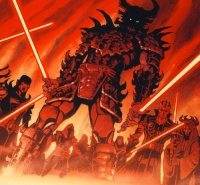 Crask would become one of Darth Krayt's earliest disciples
Crask would become one of Darth Krayt's earliest disciples
Hett ostensibly shared Carnus’ grief over the events of the Purge and seemed to possess his sense of responsibility. Carnus underwent the ritual tattooing that would come to characterize the One Sith and was given the hallowed title of Darth. Fully indoctrinated, Darth Carnus’ power broadened as he learned techniques in the Force to which he had previously not had access. Under Krayt’s Order, he began to master doctrines, methodologies, and philosophies on the Force that represented 25,000 years of Sith thought.
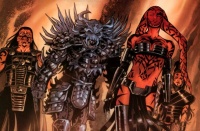 One Sith
One Sith
Yuuzhan Vong War – 19 ABY (87 years of age)
When the war against Force resistant aliens began in 19 ABY it was but one of a number of schisms that divided the galaxy. Though Carnus’ path had taken him far from his days at the Jedi Temple, he still bore a certain reverence for the Force in any incarnation, light or dark. So it was when the Far-Outsiders—utter abominations in Carnus’ eyes—invaded, he called for the One Sith to act.
However, the Dread Lord Darth Krayt harbored machinations that far outstripped the aliens and the war they had brought to the galaxy. His eyes were on the future and he did not fear the creatures and thus chose not to involve the nascent One Sith in a war whose outcome Krayt felt irrelevant to his goals. Carnus disagreed entirely and believed Krayt to have missed the significance of the invaders existence outside the Force. Krayt brooked no discord among his kind and a rift formed between the two that would ultimately see their parting.
Back to the Light – 22 ABY (90 years of age)
It was in this time that Carnus’ eyes were opened to what the One Sith would bring about. In a vision of the future, Carnus witnessed the resurgence of what he referred to as “The Next Empire” that would be brought into being by the might of the One Sith. Despite his education in Sith philosophy and receptiveness to absolutist ideals, Carnus’ memories of his persecution ran deep and he could not accept another Empire constructed in the image of the old. Though decades had passed since her death, Carnus’ sense of loss over what could have been with Meadan was ever potent. In opposing a resurgent Empire, Carnus’ grief found purpose he felt to be beyond all he had done since the twilight of the Jedi.
Coupled with Krayt’s indifference to the abominable Yuuzhan Vong, Carnus chose to alter his path again and leave yet another order behind. But nor did Carnus agree with what the son of Skywalker had wrought with the Jedi in his absence from the light. Carnus took a harsh view of the fledgling New Jedi Order under Luke Skywalker and deemed it unworthy to combat the threat of the Yuuzhan Vong. He knew he would require a force capable of both eradicating the Far-Outsiders and ultimately challenging Krayt’s bid for power that would renew the Empire.
Crask’s Reform – 22 ABY (90 years of age)
To achieve his goals, Carnus realized he could look to no Sith or purported dark sider to aid him. Those he knew of answered to Darth Krayt alone and shared his ideals. In 28 ABY Carnus would leave off the Sith mantle and once again become Omancor Crask, Jedi Master. Though the paradigm of his thought on the Force and his place in it had not shifted, he felt his ends would be best served by making his way back towards the light.
But this was not the rebirth into the light so many previous fallen Jedi had experienced. He was not “saved” in any sense. Crask was nearly as lost as he had always been but for his commitment to expel the Far-Outsiders and stop the rise of the next Empire. Still the cynical pragmatist, this was perhaps the most Sith-like action he had ever undertaken in knowing that to defeat armies of darkness, he required armies of light. He drew to him those Force-users whose motives included the old dictums of the Jedi Order: Justice and Peace, but ones that were also willing to go farther to obtain these ends than Skywalker’s band.
Crask told these new adherents what they needed to hear and kept his past and true disposition secret from even their gifted senses. None, even Khaemyn Rua and Rade, knew he had been Darth Carnus. He trained them how he knew Jedi needed to be trained to exist in times without peace. He taught them the curriculum he felt he should have been given as a student at the Temple. He replaced the cryptic, contradictory philosophies of Master Yoda with practical philosophies of politics and war. Crask created in his young Jedi what he knew the galaxy would require to survive the next storm.
For those too weak in the Force or who would not fully accept his doctrine, Crask had another lesson to teach. In his time at study in the darker arts of the Force Crask had learned to wipe away one’s abilities and imprint him with new ones. This conversion not only affected the recipient’s powers, but his mind as well giving Crask the ability to forcibly shape what he required in his adherents.
Expedition to Antei – 23 ABY (91 years of age)
In his exploits purging the galaxy of the abomination of the Far-Outsiders, Crask discovered the location of an alien task force in the remote Antei system. He was overwhelmed by the magnitude of his discovery when he realized he had found the Force resistant aliens occupying a Sith stronghold only recently abandoned. Using a virulent strain of Alpha Red obtained through a sympathetic source inside Skywalker’s New Jedi Order, Crask exterminated the alien presence on Antei and throughout the anomaly known as the Shroud in order to learn more about these dark siders of whom almost no one was previously aware.
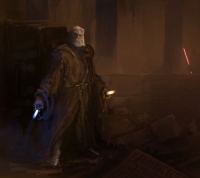 Crask at war with the Brotherhood on Antei
Crask at war with the Brotherhood on Antei
Once the aliens had been wiped out, Crask occupied the planet with a force of some fifty Jedi Knights accompanied by thousands of battle droids and several Jedi Masters. Crask had programmed his droids specifically to engage with Force-users in his preparations to eventually face the One Sith. The droids employed a variety of ballistic weaponry that negated much of a Jedi’s advantage to turn more conventional blaster bolts back on their opponents with their favored lightsabers. Crasks’ forces had also trained extensively to combat the Yuuzhan Vong and found their mass-driver weaponry effective against the galactic invaders.
In addition to his primary force of battle droids, Crask had in his service a small number of IG-100 MagnaGuards. These rare and prized vestiges of the Clone Wars were kept close-at-hand by Crask and his aides-de-camps. They were remarkably effective Jedi-killers and had received special software upgrades designed by Crask himself.
In what would become known as the Ninth Great Jedi War, Crask's forces engaged the combined elements of the Dark Jedi Brotherhood at Antei.
Demise
Crask's defeat came shortly after one of his greatest victories. The war for Antei reached a climax when Crask ostensibly surrendered himself to the Dark Lord Sarin in a gambit to put himself within striking distance of ending the conflict. On board the Brotherhood warship Exodus, Crask revealed to all his true nature and the magnitude of his power. Taking the Grand Master and his cohort by surprise, Crask quickly turned the seemingly grim situation to his advantage and engaged Sarin in single combat.
The maelstrom created by the two great lords' conflict crippled Exodus sending the cruiser spinning helplessly into Antei's gravitational pull where it was destroyed on the surface. Barely surviving, Sarin rose to meet Omancor Crask once again to finish the duel that had begun in orbit and would now conclude on the surface amongst the burning remnants of the Bothan assault cruiser.
Sarin, having lost his arm and his lightsaber, was no match for Crask as he pressed his advantage. Crask finished Sarin with a riposte that pierced the Grand Master's chest and the dark heart of the Brotherhood itself. However, moments after Sarin's death, Crask's own apprentice Rade slew the aged Epicanthix master after having learned of his betrayal and murder of Khaemyn Rua aboard Exodus. Crask had ended the war, but it was the Brotherhood that survived.
Unconfirmed Sighting
Crask's death remains shrouded in mystery following the Dark Brotherhood's inability to identify his body on the battlefields of Antei or ascertain the whereabouts of Rade. The Grand Master's Inquisitors have followed several leads that have indicated Omancor Crask was confronted by his apprentice following the death of Grand Master Sarin, but survived the encounter. It is reported that Crask defeated his apprentice and then fled Antei. These rumors remain unconfirmed as of 28 ABY.
Characteristics
Physical Appearance
His frame was compact at 1.82 meters but well-laden with muscle developed over nearly a century of hardship. Crask’s body was stocky and showed signs of his age even for an Epicanthix. But it was clear that his ruggedly tanned and battered skin still coursed with muscle and energy belying his age.
Crask’s hair was gray and often wild in appearance when not kept back from his face. Massive sideburns typically framed his square jaw that was often set grimly in disapproval of his apprentices. He wore simple garments of worn and coarse brown fabric that provided utility in warm and cold climates.
Sith Tattoos
Though few had seen them, Crask’s entire body was covered in the faded remains of Sith tattoos from his days as Darth Carnus under the One Sith. The nature of the tattoos was such that they were indelibly marked into his skin. Over time Crask used his skill to suppress them so that they appeared faded and less noticeable though the remnants could sometimes be seen on his forearms or face, where the skin was exposed, especially when angered.
His skin tone remained ruddy but much lighter than the deep red pigment his body was stained with during his initiation to the One Sith. Suppressing the tattoos was a constant struggle. His students often mistook the dark circles under his eyes for fatigue, stress, and age, but when fed by anger or hatred the tattoos re-emerged to remind Crask that he would never be far from his past.
Demeanor
Crask often walked alone in brooding contemplation. He was prone to shove his hands into the opposite sleeves of his robe and walk for hours with arms folded and head bowed. He was not easily approached and often such was done only by his senior apprentices Khaemyn Rua and Rade. Crask was not cantankerous, but was perceived so by some of the younger in his fold. He was quiet and grim. His anger was not easily roused, but could establish itself terribly and without warning hearkening back to his times of darkness.
Beliefs
The Craskian Theorem
This was the unofficial name of Crask’s particular school of thought he had developed regarding the Force. Ironically, he believed much the same as Palpatine had about the mystical energy field that bound together all living things. Crask felt there were no light or dark sides to the Force but rather it simply was and those who could touch it did with it what they would for better or worse. To Crask, intent was what mattered and the rest flowed from this core idea.
This belief nearly led him to dissent before the Jedi Order was destroyed by Order 66. It was reinforced endlessly over decades as Crask watched others die at the hands of Sidious and his apprentice Vader during the Purge until they too were struck down by the son of Skywalker. Crask did not see this as the holy restoration of “good” over “evil” as did the rest of the galaxy. To him this was yet another lesson that intent fueled with enough power achieved anything.
Yet Crask respected this synergy of will and power. He respected it and its origin: the Force. Where so many had trivialized it through its casual use, Crask maintained that like all power, it should be respected and thus not invoked lightly. So Crask and his followers did not employ it randomly or unnecessarily. It was used when needed and nothing more. The common uses by Skywalker’s New Jedi Order and Sidious’ fallen regime were viewed as perverse, vulgar displays of power by Crask’s Jedi. Clear evidence that their institutions of authority were corrupt and invalid. In Crask’s mind, one who abused his power so was fit to neither wield it nor see his will done through it.
Important Relationships
To understand Omancor Crask is to understand a man at odds with the precepts of his world. Crask's path was influenced by several key relationships throughout his long history and three among them were the most important.
Meadan Clor
A young human female, Meadan was Crask's first apprentice as a master in the twilight of the Jedi Order. Meadan was exceptionally bright and well-gifted in the Force, but what drew Crask to her was her intensity and drive to succeed. These qualities were rare in one so young. Crask found them lacking even in ones who had already attained Knighthood. He could not help but admire his student as he guided her for her fierce devotion to the Force. It was clear to him that somewhere this young woman had been instilled with personal standards beyond even what the Order expected of its students. Crask knew it had less to do with his tutelage and more to do with something intrinsic to her nature and being.
As things turned worse for the Order and Crask's beliefs were tested, Meadan had come to be less a student and more a constant center to him. The lines of their relationship blurred and drew criticism from the Jedi Council and other masters of the Order. Crask would later reflect with bitter irony on the Council's knowledge of his feelings for Meadan yet utter blindness to Palpatine's insidious plot in their very midst.
When Order 66 was issued, Crask and Meadan made plans to escape and rendezvous at Kessel with others fleeing the Purge. When Meadan's vessel was intercepted by elements of the new Imperial Navy and 501st Legion, she and her fellow refugees were slaughtered to a man. Meadan Clor's murder, coupled with his doubts-turned-disgust with the Order, pushed Crask into a very dark place in his life. His inability to predict what had befallen them, nor stop it, led to unmittigated rage and guilt that pushed wide the door to the dark side of the Force.
Khaemyn Rua
More to follow...
Rade
Rade was like a son to Crask. Though large and powerfully built for a human, Rade's physical gifts were far outstripped by those he possessed in the Force. The seemingly perfect Rade was a natural favorite of Crask's.
As Rade matured under Crask's guidance, he grew into a man who challenged and questioned the things around him. Crask secretly liked the young man all the more for it but at the same time found it troubling as the usually obedient Rade became more difficult to control.
The war against the Brotherhood further strained the pair's relationship as Rade expressed grave reserve over the merit of the endeavor. Ultimately he obeyed his master's will, but Crask knew the gamble he had taken on Antei and that if his true intentions were discovered, Rade would move against him.
What Crask did not perceive, or perhaps react appropriately to, were Rade's feelings for Jedi commrade Khaemyn Rua. This failure to recognize feelings Crask himself should have been intimately familiar with ultimately led to his downfall.
Special Powers and Abilities
Affect Force Imprint
As Darth Carnus, Crask had mastered the terrifying ability to strip one not only of his connection to the Force, but his very identity as a free-thinking being. He could then imprint his victim with a perspective that made him amenable to Crask's will effectively proselytizing his opponents instantly. This power most closely resembled Affect Force Imprint to students of the Brotherhood's dark arts but was far more refined.
Alternatively, Crask could seize one who was Force-deaf and imprint that subject with primitive and undisciplined, yet powerful, abilities turning them into what became colloquially known as a "Berserker" during the Ninth Great Jedi War. These Berserkers could be transformed in seconds from loyal soldiers of Crask's enemies to wild and flailing conduits of deadly Force Lightning and other manifestations turned back on their masters. Berserkers seldom lived long beyond their transformation.
Emerald Lightning
More commonly known as Electric Judgment, Emerald Lightning was a technique that Crask employed over his enemies. Unlike standard Force lightning, however, this particular lightning was employed by Jedi rather than Dark Jedi. While it was true that Electric Judgment could cause a person to convulse and die, it was normally used to drain an individual's willpower and strength, rendering him entirely vulnerable to his opponent.
Considering the pride of the Dark Jedi, Crask found Emerald Lightning to be incredibly useful, implementing it in battles and wars. He chose to call his technique Emerald Lightning due to the brilliant emerald color of the sparks and bolts he shot out in an enemy's direction.
Possessions and Artifacts
The Holocron of Omancor Crask
Constructed in the time of his return to the light, Crask’s holocron is in the traditional Jedi design of a cube. Though versed in the construction of a pyramidal—arguably superior—Sith holocron, Crask chose the Jedi technique so that his lessons and teachings would not be mistaken for dark side madness and they would be accessible to more Force-users after his passing. In his holocron, Crask detailed the synthesis of ideas he explored while both Jedi and Sith and used the device as a memoir of his life.
The holocron was also believed to contain the text of Crask’s treatise: The Intent of Power.
The Sword of Shadday Potkin
Omancor’s original lightsaber was destroyed in the ensuing chaos of Order 66. Following the death of his apprentice Meadan Clor, enroute to the Conclave on Kessel, Crask retrieved the cortosis sword of Jedi Master Shadday Potkin. Herself slain at the meeting by Darth Vader, the blade was mistakenly left behind still buried in the chest of Koffi Arana.
A short-sword in design, the blade was extremely effective at close-range and its metallurgic properties made it a formidable weapon especially when pitted against a lightsaber. The weapon had taken the lives of several Jedi Masters as well as having wounded Darth Vader himself. Crask believed it possible the blade had become tainted by the hatred it had been wielded with.
The Sith Robes of Darth Carnus
Ornate robes saved by Crask as a reminder of how easily the fallacy of his trappings could define who he was.